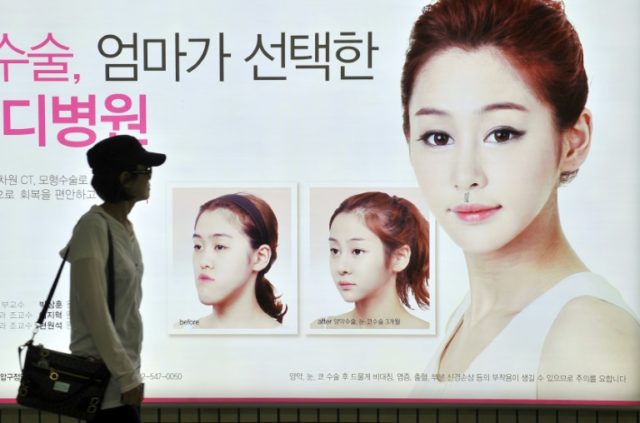Paris (AFP) – Demand for cosmetic surgery is showing no sign of abating, with a boom in Asia as the procedures become more affordable and less of a taboo, experts said.
The global market grew by 8.3 percent in 2016 to an estimated value of 8.5 billion euros ($8.9 billion) — the GDP of the Bahamas, according to data released Friday at the IMCAS aesthetic industry conference in Paris.
In 2017, people are projected to spend 9.2 billion euros on face and body upgrades, growing to nearly 12 billion euros in 2020.
“There’s a general acceptance that doing, whether it’s surgery or less invasive procedures… to make you feel better, look better, it’s much more accepted,” Nolan Karp, a New York surgeon and board member of the American Society for Aesthetic Plastic Surgery, told AFP.
Demand in Asia is exploding, practitioners say, driven by a rapidly growing middle class and a quest for more Caucasian features.
Behind the United States and Brazil, South Korea was the third biggest market for aesthetic treatments in 2015, with 1.2 million procedures out of a global total of 21.7 million, according to data from the International Society of Aesthetic Plastic Surgery (ISAPS).
While breast augmentation and liposuction are the most popular procedures in America, Brazil, Mexico and most of Europe, demand in South Korea is for eye, nose, cheek and chin resculpting.
“They (clients) will be treating areas of the face that will make them look like Europeans or Americans,” Laurent Brones, and industry expert, told AFP.
IMCAS data shows the Asia Pacific region will be the fastest grower, at 12 percent in the coming four years — overtaking Europe for the first time in 2020 to represent a quarter of the global market at over three billion euros.
– Machines overtaking scalpels –
Less-invasive procedures such as laser treatments to tighten or “rejuvenate” skin, toxin injections to paralyse face muscles and ease frown lines, chemical peels, and freezing and killing unwanted fat, are fast overtaking traditional surgery.
More and more clients opt for procedures that require no anaesthesia, less recovery time, and present fewer risks.
“The growth of non-surgicals is pretty much exponential,” ISAPS president Renato Saltz told AFP.
“The technology, the money invested in research and development, is just mind boggling. If you look at the industry, they don’t make money with a scalpel, but they do make money with machines.”
In 2015, Botox injections were the most popular procedure with 4.6 million performed by plastic surgeons, followed by hyaluronic acid injections (2.9 million) to iron out wrinkles and plump up lips.
Surgical breast augmentation was in third place with 1.5 million procedures, followed by liposuction with 1.4 million and operations to lift and shape eyelids at 1.3 million.
Some foresee that more and more men, who make up about a tenth of clients today, will be drawn in.
Slowing or reversing hair loss, for example, “is a huge potential market,” said Bernard Mole, a Paris-based plastic surgeon.
Balding can be very distressing for many men, he said.
Hair implantation technology has improved and there is a drug that promises to boost growth — but these are expensive and take a long time — leaving a huge gap for a “miracle” hair drug.
Genital resculpting is another wide open field.
“The demand is not there yet, but 10/15 years ago there was also no demand for female genital rejuvenation,” said Mole.
Today it is among the most popular procedures, “and I believe that in five to ten years we will see the same trend in men.”

COMMENTS
Please let us know if you're having issues with commenting.